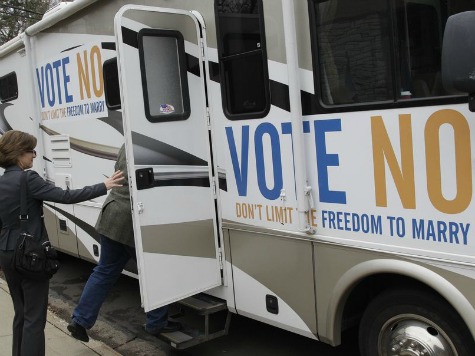
In November, voters in four states — Minnesota, Maine, Maryland, and Washington — handed election day victories to supporters of same-sex marriage initiatives, a marked contrast to the 2008 defeat they experienced with California’s Proposition 8.
President Obama won all four states rather handily, with the narrowest margin (8%) in Minnesota and the widest margin (25%) in Maryland. The same-sex marriage initiatives ran significantly behind the President in all four states, where the margin of victory ranged from 4% to 5%.
In Minnesota, a same-sex marriage ban was narrowly defeated, 51.2% to 47.5%. The margin of victory was slightly more than 110,000 votes (1,512, 156 to 1,401,275). Obama won Minnesota by a wider margin, 53% to 45%.
In Maine, a measure to legalize same sex marriage won narrowly, 52.7% to 47.3%. The margin of victory was slightly more than 35,000 votes (366,071 to 329, 143). Obama won Maine by a wider margin, 56% to 41%.
In Maryland, a measure to legalize same-sex marriage also won narrowly, 52.1% to 47.9%.The margin of victory was barely over 100,000 votes (1,258,952 to 1,156,578). Obama ran far ahead of this ballot measure in Maryland, 62% to 37%.
In the state of Washington, the measure to legalize same sex marriage passed with slightly more breathing room, 53.2% to 46.8%. The margin of victory was slightly more than 185,000 votes (1,527,272 to 1,341,926). Obama won the state by a comfortable 56% to 42% margin.
On Tuesday BuzzFeed reported that electoral success for supporters of same-sex marriage were the result of careful research and different messaging:
The surprise sweep for marriage equality efforts at the polls in 2012 came after a dramatic shift in the television ads their backers ran — a change that came about after a yearlong research effort to crack the code of previously successful ads run by marriage-equality opponents that focused on “gay marriage” being taught in schools.
Among the key changes were a shift away from talk of “rights” to a focus on committed relationships; a decision to address “values” directly as being learned at home; and an attempt to give voters “permission” to change their minds…
When Proposition 8, which banned same sex marriage, passed by a margin of 52% to 47% in the state of California in 2008, much of the measure’s success came from an effective television advertising program featuring a young girl telling her mother, “I can marry a princess.”
Four years later, same-sex marriage supporters offered a series of television ads tailored to the demographics of each of the four states that focused on “commitment” rather than “rights.”

COMMENTS
Please let us know if you're having issues with commenting.